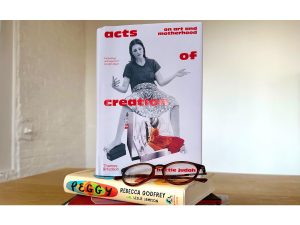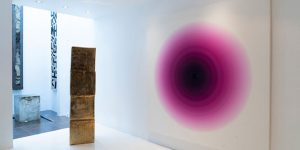How would you describe your painting practice? Do you start with an idea, with research, and with a line drawing that eventually becomes your completed process? Your method of accentuating the drawn lines in some of your work is like a magic trick that adds subtle but powerful emphasis. Who would guess that pencil shavings would play a part (and what number pencil)?
There’s never a single path. For smaller works or drawings, sometimes it’s as simple as moving the pencil until an image surfaces. But with larger works, the process has been more varied for the past few months. I’ve been in the early stages of planning an upcoming exhibition at Charleston in Lewes, which has come from years of interest in the history of the Bloomsbury Group, but at the moment it exists only in my head as a foggy collection of colors and the idea that the paintings should feel like movement through a busy household. Simultaneously, I’m preparing a painting for Frieze London based on a smaller drawing that I just finished and feel could be explored further in a larger format. I’m also sketching a digital draft for landscape painting that will show at the Kemper Museum this fall. All this to say, each work or body of work has different needs in terms of its beginnings and progression. Some take painfully long to sketch, some are drafted by hand, others digitally, and some feel like a puzzle that doesn’t fit until thoroughly explored. The one constant with larger works is that there’s generally a long period of drafting, projecting, nudging lines, and revisions before I start physically working on a piece.
As far as material, line is always a key element in my work, but its treatment varies with each painting. If a piece needs to feel tender, I leave areas of the linen exposed or lightly dyed, as in the patterning in Nancy in Blue. For visually layered pieces, where I want to present two images as an overlay and create the sense of coexisting thoughts, I’ll build up the lines by sifting wood from my pencil shavings and mixing it into a paint that’s then sculpted off the canvas in order to create distance between the lined image and the painted background, as in The Shell and Magritte’s Door. It’s important to me that my process reflects the essence of each work, and over time, my techniques have evolved to support this.
How long does this take, or do you maybe work on several paintings that become a larger opus?
Generally, I’ll work on a body of work collectively so that each piece informs the others. There might be one that acts as an initial catalyst, but it’s always quickly followed by works that I feel have to exist in tandem. It’s like the first piece operates as a question, and the following works are answers, but at the same time, they are all iterations trying to say the same thought or mood in a different tone. For example, the first work for an upcoming show at Perrotin was Margrethe Summer, a painting of a wide-eyed woman sitting at a table, tongue out, and ready to receive a raspberry from an equally wide eyed bird. The work reflects both my childhood in Michigan and an idyllic connection with nature, though there’s always an underpinning of feverish worry. The sketches for the following works build on this in the form of repeating imagery: nature represented as shadows and silhouettes; doorways or windows as portals between the world of the interior and nature; and spirals symbolizing both loss of control, internal safety, and retreat, like a shell.




